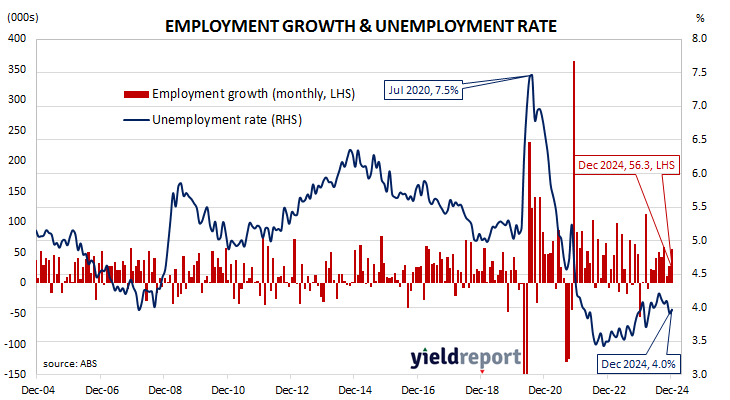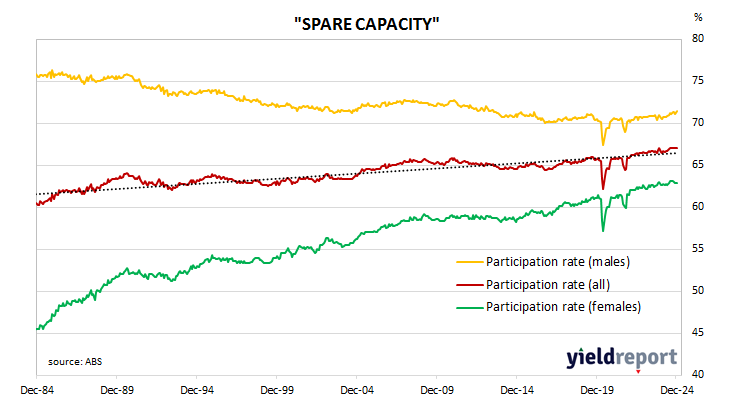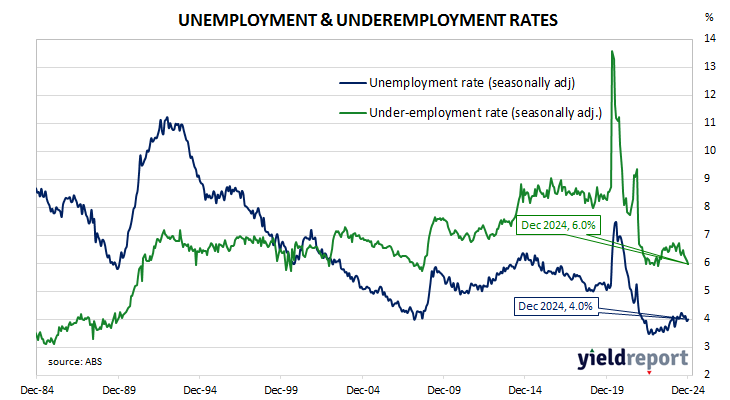Summary: Employment up 56,300 in November, greater than expected; Westpac: easing in labour market conditions has paused over second half of 2024; ACGB yields fall; rate-cut expectations firm; ANZ: jobless rate at/near 4% may be consistent with underlying inflation in RBA’s target band; participation rate back to series high at 67.1%; jobless rate rises to 4.0%; more part-time jobs, fewer full-time jobs; aggregate work hours up 0.5%; underemployment rate falls to 6.0%.
Australia’s period of falling unemployment came to an end in early 2019 when the jobless rate hit a low of 4.9%. It then averaged around 5.2% through to March 2020, bouncing around in a range from 5.1% to 5.3%. Leading indicators such as ANZ-Indeed’s Job Ads survey and NAB’s capacity utilisation estimate suggested the unemployment rate would rise in the June 2020 quarter and it did so, sharply. The jobless rate peaked in July 2020 but fell below 7% a month later and then trended lower through 2021 and 2022.
The latest Labour force figures have now been released and they indicate the number of people employed in Australia according to ABS definitions increased by 56,300 in December. The rise was considerably greater than the 15,000 increase which had been generally expected as well as November’s upwardly-revised increase of 28,200.
“The December Labour Force Survey provided further support to the narrative that the easing in labour market conditions, that has been in place since late-2022, looks to have paused over the second half of 2024,” said Westpac economist Ryan Wells. “This is supported by evidence of robust employment growth, a relatively stable level of average hours and the fact that the key measurements of labour underutilisation are the same or lower than they were a year ago.”
Commonwealth Government bond yields fell noticeably on the day following similar moves by US Treasury yields on Wednesday night. By the close of business, the 3-year ACGB yield had lost 10bps to 3.94%, the 10-year had shed 13bps to 4.53% while the 20-year yield finished 10bps lower at 4.95%.
Expectations regarding rate cuts in the next twelve months firmed, with a February cut currently viewed as a good chance. Cash futures contracts implied an average of 4.275% in February, 4.005% in May and 3.785% in August. December contracts implied 3.645%, 69bps less than the current cash rate.
“Although the labour market remains resilient, the sharper-than-expected slowdown in wage growth in 2024 and weaker inflation forecast for Q4 suggest that an unemployment rate at or just below 4% may be consistent with underlying inflation in the target band,” said ANZ senior economist Adelaide Timbrell.
The participation rate ticked up from 67.0% in November’s to 67.1%, the series’ high, as the total available workforce increased by 66,600 to 15.189 million. The number of unemployed persons increased by 10,300 to 604,100 and, as a result, the unemployment rate ticked up from 3.9% to 4.0%.
The aggregate number of hours worked across the economy increased by 0.5% as 80,000 residents gained part-time positions and 23,700 residents lost full-time positions. On a 12-month basis and after revisions, aggregate hours worked increased by 3.2% as 145,400 more people held part-time positions and 299,000 more people held full-time positions than in December 2023.
More attention has been paid to the underemployment rate in recent years, which is the number of people in work but who wish to work more hours than they do currently. December’s underemployment rate declined from 6.1% to 6.0%, 0.2 percentage points above this cycle’s low.
The underutilisation rate, that is the sum of the underemployment rate and the unemployment rate, has a strong correlation with the annual growth rate of the ABS private sector wage index when advanced by two quarters. December’s underutilisation rate of 10.0% corresponds with an annual growth rate of about 4.2%.




